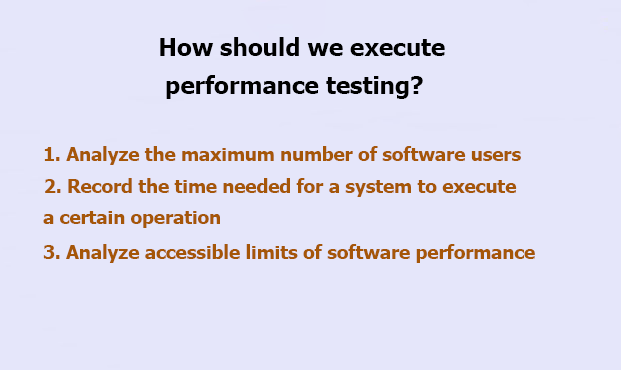Every QA engineer should possess performance testing skills that help to understand the stability of a tested application and also, analyze several values of its performance and its reaction to exposure of various kinds.
The purpose of such testing is to find actual flaws and evident weaknesses of a system, define exact data upload speed and its further processing, and general reliability of an application.

Performance Testing Types
How should we execute performance testing?
We can check system performance by:
- Analyzing the maximum number of software users;
- Recording the time needed for a system to execute a certain operation;
- Analyzing accessible limits of software performance at different types of load.
Performance testing comprises the following types of tasks;
- Load testing;
- Stress testing;
- Endurance testing;
- Configuration testing.
Let’s overview all types of performance testing. We will start with load testing.
Load testing
Load testing helps to define if the application in test can work smoothly at permissible load and after increasing the accessible limits of exposure to a little bit higher level.
This type of testing will help to check software behavior at a high system load.Load may entail a total number of users that can simultaneously interact with software functionality for a certain amount of time.
This type of testing will help to define a maximum time response range during important business operations. By analyzing database behavior and network behavior, you can find weak spots in software and fix them successfully.
Configuration testing
It’s testing software performance on various OS, software configurations, and also, their system compatibility.
This testing helps to define actual parameters of software performance at middle and high (accessible) values of system load.This type of performance testing ensures a user that the system in test works properly with various operating configurations and settings.
A simple and clear example of such testing is testing a website on devices with flagman operating “filling” (iPhone 11 Pro or Samsung S20) and smartphones that were launched several years ago (such as Lenovo A76 or Samsung Galaxy J6).
These tests will help to find the most proper (optimal ) configuration to work smoothly with software and other web products.
You can also check a website on mobile OS or desktop versions of the most popular OS.
Stress testing
These tests are executed during unexpected changes in a load level, much higher than the established (estimated) levels.
This testing helps to define the way a system and an application function under the most unexpected conditions and also, gives the possibility to check if the system in test continues functioning right after facing unexpected (unusual) situations.
Stress here is the process of increasing the severity of execution of established operations, that reaches the maximum values, or rapid changing of the configuration of the server that is being used.
Stress testing can be executed not only with software but with a simple PC, to understand the way it functions, by using a simple example.
For example, during such tests, you can load a processor, RAM, and so on.
For testing a processor, you can use console commands that will load all cores, for example:
stress-ng –class cpu –sequential 8 –timeout 60s —metrics-brief
A system will execute various mathematical operations, sorting, encryption, compression, finding, working with lines, and so on.
To check RAM, you can use console commands, such as:
stress-ng –class memory –sequential 8 –timeout 60s –metrics-brief
Endurance testing
It helps to check how long software will be able to work smoothly at the average system load.You should also try to find possible memory leaks, incorrect software settings, test the process of relaunching the servers during load, and other aspects that can influence the correct software performance. As for the time needed for executing an operation, it’s not so important.
There are numerous programs and applications that allow performing qualitative endurance testing. For example, Apache Bench software that can send a required number of requests and a total number of flows of these requests.

How Should We Execute Performance Testing
Popular software performance testing tools
For executing performance testing, you can also use various tools that will help to simplify the everyday work of a tester.
Below, you can find the list of such tools that are the most popular for today.
- LoadView – is a very popular tool for performance testing. The most popular parameters of this tool are: working with the “point and click” scripts, a big cloud infrastructure, testing in real web browsers;
- Apache JMeter is the software for executing various scripts of performance testing. The product gives the possibility to register new users that can operate the scripts that have been established by software;
- MSI Afteburner is the tool that helps to show the overlay of different features and monitor the number of system resources consumed by software that is being tested;
- FPS Meter shows FPS numbers (a total number of shots for 1 second) over the windows in any software or a computer game;
- GameBench allows viewing system load while playing a game.
To conclude, we’d like to say that performance testing is a very important part of software testing that helps to check its proper performance.
Such testing has various types and also use cases that help to look at software system capability from different perspectives.










Leave A Comment